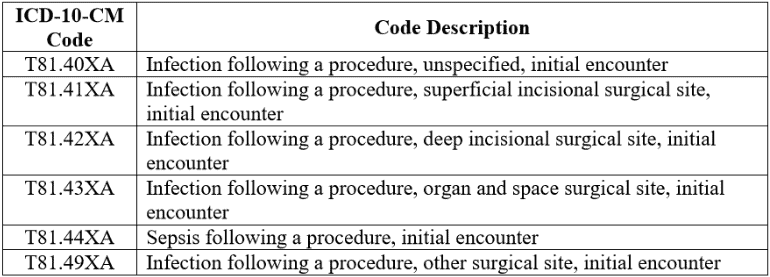Inside Angle
From 3M Health Information Systems
How deep is that infection? FY19 brings updates to codes affecting quality
I did NOT enjoy the disco years, but as I was thinking about this blog, a song lyric popped into my head: “How deep is your love…I really need to know.” When it comes to surgical site infections, this is true more than ever.
Every August the final rule is published and with it comes the fun in finding all the new changes. If anyone really wants to have fun, reading the final rule provides interesting commentary and thoughts behind the code changes. CMS has expanded the code for infection following a procedure (T81.4XXA) to include the following:
As always, one must wonder why CMS expands codes. In this case, CMS did not comment on why the new codes were created. However, it seems obvious. Infection following a procedure is a very generic term that can range from a simple superficial wound infection to deep infections with organ involvement, and even sepsis. The clinical significance and resource consumption is vastly different dependent on what type of wound infection the patient has. When tracking quality of care and outcomes, the true “crimes” are those that involve evolution to sepsis and those with deep infections. The superficial wound infections may not even require an admission and may result in a short stay.
Note this classification of wound infections is not new. NHSN (National Healthcare Safety Network) has long utilized this classification. It required abstraction (manual review) to report which could lead to over or underreporting. Additionally, to truly study quality of care, outcomes, resource consumption (cost), etc., claims data is needed. With the creation of codes matching reported measures, hospitals and agencies can more easily track, monitor and improve quality of care (and perhaps prevention) for patients with wound infections.
The code expansion has also affected the HACs (Hospital Acquired Conditions) list as the new codes are included in the HACs for infection following orthopedic, CEID (cardiac electronic implantable device) and bariatric surgeries. I also wonder if the creation of these will affect which SSIs are reported under the NHSN requirements for the Value Based Purchasing (VBP) and the HAC Reduction Program. Right now all of the SSIs are reported. Definitely something to watch.
How deep is that infection? We certainly will need greater detail from providers. This can be a delicate conversation/query. By being up front with providers and sharing why we need greater specificity, the result should be improved documentation, engaged and appropriate query responses and more accurate clinical pictures. Let the codes tell the story.
Join Audrey Howard and I for the next 3M Quality Webinar where will discuss these new codes as well as other code changes affecting quality outcomes.
Cheryl Manchenton is a senior inpatient consultant and project manager for 3M Health Information Systems.



